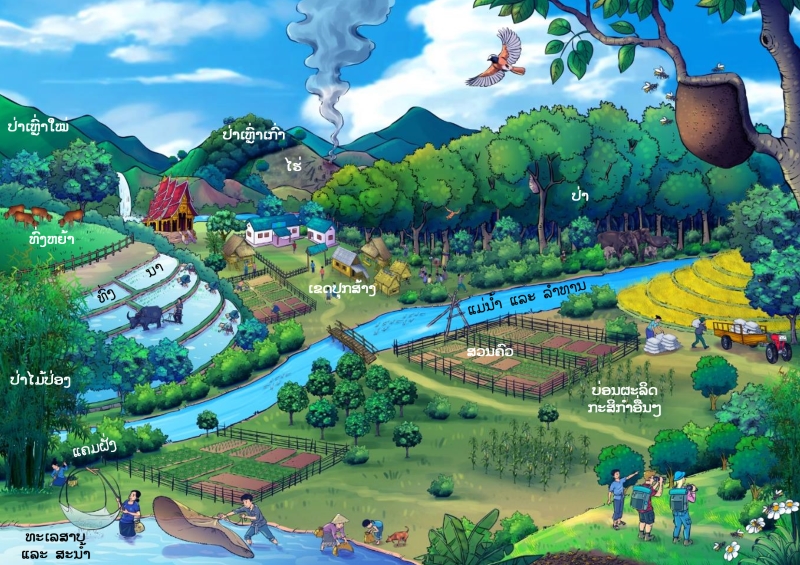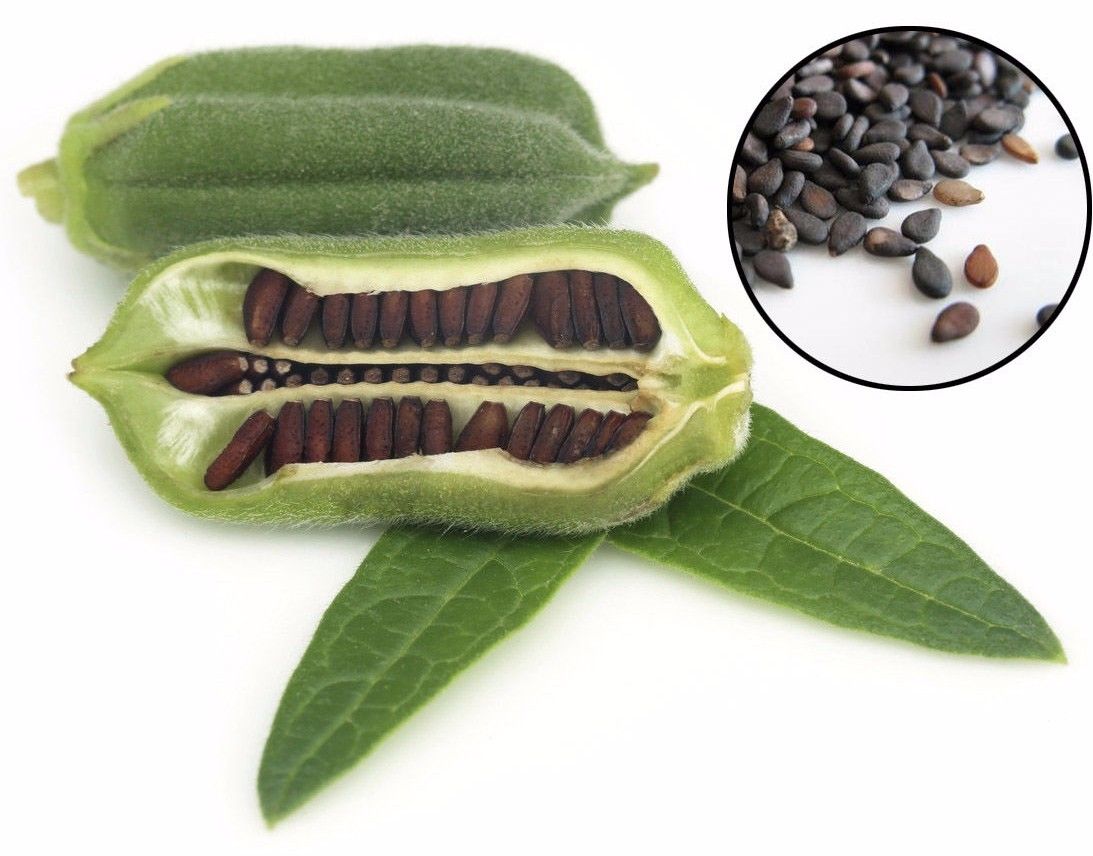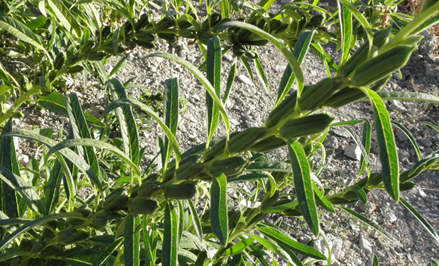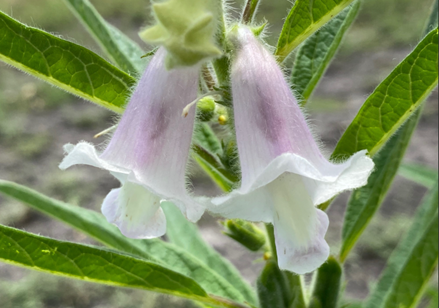ເລກລຳດັບທີ: 765
ລະດັບການຮວບຮວມຂໍ້ມູນ: ເກີອບສົມບູນ
ປັບປູງຄັ້ງລ່າສຸດ: N/A
ງາດຳ
Black Sesame Seeds
Sesamum indicum L.
ພືດ
ພືດລົ້ມລຸກ
ຜັກ ແລະ ພືດລົ້ມລຸກ
×
ຊື່ທ້ອງຖີ່ນ:
ງາຫຼໍ່ ( Benniseed, benneseed, Sesame)
ຊື່ພ້ອງ
:
Sesamum occidentale Heer & Regel
Sesamum oleiferum Sm.
Strobilanthes gentiliana H.Lév.
Sesamum oleiferum Sm.
Strobilanthes gentiliana H.Lév.
ຊື່ສະກຸນ:
Pedaliaceae
ຊະນິດໃກ້ຄຽງ:
ງາຂາວ/ Nga khao
ບັນຍາຍລັກສະນະທາງພືດສາດ:
ເປັນພືດສະໝູນໄພປະຈຳປີທີ່ມີລຳຕັ້ງຊື່ ມີຄວາມສູງແຕ່ 10 ຫາ 120 ຊມ ແລະ ມີລັກສະນະເປັນລຳຕົ້ນດຽວ ຫຼື ມີງ່າເປັນຮູບສີ່ຫຼ່ຽມມົນ, ມີຂົນອ່ອນໆ ສີຈືດໆ ແລະ ມີລັກສະນະເປັນຕ່ອມບາງສວນ. ໃບມີຮູບຮ່ງແຕກຕ່າງກັນຢ່າງຫຼວງຫຼາຍ ໂດຍປົກກະຕິຈະເປັນ Heteromorphic ແລະຈັດລຽງກົງກັນຂ້າມຫຼືສະລັບກັນ. ໃບດ້ານລຸ່ມມີກ້ານໃບຍາວ (ກ້ານໃບຍາວ 3-11 ຊມ) ແລະ ເປັນຮູບໃບຫອກ, ຮູບໄຂ່ 3 ແສກ ຫຼື 3 ໃບ ມີຂະຫນາດ 4-20 x 2-10 ຊມ. ແຜ່ນໃບມີຮູບໄຂ່ ຫຼື ຮູບສ້ວຍມຸມເຫວີ ປາຍແຫຼມ, ແລະ ຂອບໃບລຽບ. ໃນທາງກົງກັນຂ້າມ ໃບເທິງຍອດມີກ້ານໃບສັ້ນກວ່າ (ກ້ານໃບຍາວ 3-5 ຊມ) ເເຄບ ແລະ ຮູບຫອກແກມຍາວ ຫຼື ຮູບຫອກຊື່ ໂດຍປົກກະຕິແລ້ວ ກວ້າງ 0.5-2.5 ຊມ ມີຂອບໃບລຽບ ແລະ ໂຄນໃບແຄບ. ໃບທັງໝົດມີຂົນອ່ອນໆບາງໆ ແລະ ມີຄວາມແຕກຕ່າງກັນຂອງຕ່ອມ.
ດອກມີສີຂາວ, ສີບົວ, ຫຼື ສີບົວອົມມ່ວງເຂັມ ມີກາບດອກຄົງທີ່ ແລະ ກາບດອກຍາວ 1.5-3.3 ຊມ ເມື່ອເບິ່ງຈາກດ້ານທາງຂ້າງ ຈະມີລັກສະນະຍາວເປັນຮູບວົງແຄບ ມີຮ່ອງ 4 ຮ່ອງໂຄນ ແລະ ຂະຫນາດ 1.5–3.0 x 0.6–0.7 ຊມ. ພວກມັນມີປາຍໃບກວ້າງ, ສັ້ນ ແລະ ຝາແຄບຊູນມັກຈະບໍ່ລຽບ, ມີເສັ້ນດ່າງຕາມແນວນອນທີ່ສະທ້ອນເຖິງຮ້ອຍຫຍັກຂອງແກ່ນ. ແກ່ນມີແນວນອນ, ບໍ່ມີປີກ ແຕ່ມີຂອບສອງດ້ານທີ່ບໍ່ຊັດເຈນ, ເປືອກເມັດກ້ຽງທີ່ຄືກັບເສັ້ນດຳເລັກນ້ອຍ, ເມື່ອມັນໃຫຍ່ເຕັມທີ ຈະສີດໍາ, ສີນ້ຳຕານ ຫຼື ສີຂາວ. ໝາກງາ (Sesamum indi-cum L.) ພືດ ແລະ ການບໍລິໂພກຂອງມະນຸດທີ່ຜະລິດຂື້ນໃນຊ່ວງທຳອິດ.
ແຫຼ່ງທີ່ມາ: [1], [2]
ດອກມີສີຂາວ, ສີບົວ, ຫຼື ສີບົວອົມມ່ວງເຂັມ ມີກາບດອກຄົງທີ່ ແລະ ກາບດອກຍາວ 1.5-3.3 ຊມ ເມື່ອເບິ່ງຈາກດ້ານທາງຂ້າງ ຈະມີລັກສະນະຍາວເປັນຮູບວົງແຄບ ມີຮ່ອງ 4 ຮ່ອງໂຄນ ແລະ ຂະຫນາດ 1.5–3.0 x 0.6–0.7 ຊມ. ພວກມັນມີປາຍໃບກວ້າງ, ສັ້ນ ແລະ ຝາແຄບຊູນມັກຈະບໍ່ລຽບ, ມີເສັ້ນດ່າງຕາມແນວນອນທີ່ສະທ້ອນເຖິງຮ້ອຍຫຍັກຂອງແກ່ນ. ແກ່ນມີແນວນອນ, ບໍ່ມີປີກ ແຕ່ມີຂອບສອງດ້ານທີ່ບໍ່ຊັດເຈນ, ເປືອກເມັດກ້ຽງທີ່ຄືກັບເສັ້ນດຳເລັກນ້ອຍ, ເມື່ອມັນໃຫຍ່ເຕັມທີ ຈະສີດໍາ, ສີນ້ຳຕານ ຫຼື ສີຂາວ. ໝາກງາ (Sesamum indi-cum L.) ພືດ ແລະ ການບໍລິໂພກຂອງມະນຸດທີ່ຜະລິດຂື້ນໃນຊ່ວງທຳອິດ.
ແຫຼ່ງທີ່ມາ: [1], [2]
ນິເວດວິທະຍາ
ເຂດກະຈາຍພັນທົ່ວໂລກ:
Native to Southern America, Africa and Asia. Source: [3]
ເຂດກະຈາຍພັນໃນລາວ
:
ເຂດພູສູງພາກເໜືອຂອງລາວ
ລຽບແມ່ນ້ຳຂອງພາກເໜືອ
ເຂດພູສູງສາຍພູຫຼວງ ແລະ ເຂດພູພຽງແຂວງຊຽງຂວາງ
ທົ່ງພຽງວຽງຈັນ
ເຂດສາຍພູຫຼວງພາກເໜືອ
ເຂດສາຍພູຫຼວງພາກກາງ
ເຂດສາຍພູຫຼວງຕອນລຸ່ມ
ສາຍພູຫຼວງພາກໃຕ້
ເຂດລຽບແມ່ນ້ຳຂອງພາກໃຕ້
ລຽບແມ່ນ້ຳຂອງພາກເໜືອ
ເຂດພູສູງສາຍພູຫຼວງ ແລະ ເຂດພູພຽງແຂວງຊຽງຂວາງ
ທົ່ງພຽງວຽງຈັນ
ເຂດສາຍພູຫຼວງພາກເໜືອ
ເຂດສາຍພູຫຼວງພາກກາງ
ເຂດສາຍພູຫຼວງຕອນລຸ່ມ
ສາຍພູຫຼວງພາກໃຕ້
ເຂດລຽບແມ່ນ້ຳຂອງພາກໃຕ້

ເຂດກະຈາຍພັນຕາມພູມສັນຖານ
:
ທົ່ງນາ
ເຂດຜະລິດພືດຜົນເນີນສູງ
ປ່າເຫຼົ່າອ່ອນ
ເຂດກະສິກຳອື່ນໆ
ສວນຄົວ
ເຂດຜະລິດພືດຜົນເນີນສູງ
ປ່າເຫຼົ່າອ່ອນ
ເຂດກະສິກຳອື່ນໆ
ສວນຄົວ

ສະເພາະຖິ່ນໃນລາວ:
ພື້ນເມືອງ
ຮຸກຮານ
:
ບໍ່ຮຸກຮານ
ສະຖານະພາບການອະນູຮັກ IUCN
:
ບໍ່ມີຄວາມສ່ຽງ
ສະຖານະພາບການອະນຸຮັກແຫ່ງຊາດລາວ
:
ບໍ່ຖືກລະບຸໃນບັນຊີປະເພດໃດ
ການນຳໃຊ້
ປະເພດການນຳໃຊ້:
ອາຫານ
ພືດເປັນຢາ
ພືດເປັນຢາ
ບັນຍາຍການນຳໃຊ້:
ເຖິງແມ່ນວ່າແກ່ນຫມາກງາຖືກໃຊ້ທົ່ວໄປເປັນສ່ວນປະກອບໃນຜະລິດຕະພັນອາຫານຕ່າງໆ ທີ່ສໍາຄັນແມ່ນປຸງແຕ່ງເປັນນ້ຳມັນ ແລະ ອາຫານຫຼັກໃນປະລິມານຫຼາຍ. ນ້ຳມັນງາຖືວ່າເປັນນ່າສັງເກດເປັນພິເສດເນື່ອງມີ ສານຕ້ານອະນຸມູນອິດສະລະ ໃນປະມານສູງ ແລະ ອົງປະກອບຂອງໄຂມັນທີ່ເປັນປະໂຫຍກຕໍ່ຮ່າງກາຍ ສານຕ້ານອະນຸມູນອິດສະລະທີ່ສໍາຄັນເຊັ່ນ: sesamin, sesamol ແລະ sesamolin ມີສວນຊ່ວຍໃຫ້ນ້ຳມັນງາຄົງຕົວ ແລະ ອາຍຸການເກັບຮັກສາດົນນານ. ອາຊິດ Oleic (C18: 1) ແລະ linoleic ac-id (C18: 2) ກວມເອົາຫຼາຍກວ່າ 80% ຂອງໄຂມັນທັງຫມົດ ຊ່ວຍຄຸນນະພາບຂອງນ້ຳມັນສໍາລັບການບໍລິໂພກຂອງມະນຸດ. ນອກຈາກນັ້ນ, ອາຊິດໄຂມັນ ເຫຼົ່ານີ້ແມ່ນຈະຊ່ວຍຫຼຸດລະດັບຄໍເລດເຕີລອນໃນເລືອດ ຫຼຸດຜ່ອນຄວາມດັນເລືອດສູງ ແລະພາວະເຊັ່ນ: ຫຼອດເລືອດແຂງ, ໂລກຫົວໃຈ ແລະ ມະເຮັງບາງຊະນິດ. ນອກຈາກນັ້ນ, ແປ້ງເມັດງາ ຍັງອຸດົມໄປດ້ວຍໂປຣຕີນ ແລະ ກົດອະມີໂນ ທີ່ຈຳເປັນເຊັ່ນ: Methionine ແລະ Tryptophan ເຊິ່ງນ້ຳມັນປະມານ 10 ຫາ 12%, ມີແຄວຊຽມຫຼາຍກວ່ານົມສາມເທົ່າ ແລະ ລະດັບວິຕາມິນ, ແມກນີຊຽມ, ແລະ ຟອສຟໍຣັດໃນປະລິມານສູງ. [4]
ການປູກ ການລ້ຽງ:
ປູກ ແລະ ທຳມະຊາດ
ລະດູການເກັບກູ້:
ມັງກອນ
ກຸມພາ
ພະຈິກ
ທັນວາ
ກຸມພາ
ພະຈິກ
ທັນວາ
ການຕະຫຼາດ ແລະ ຕ່ອງໂສ້ມູນຄ່າ:
N/A
ການຄຸ້ມຄອງຈັດການ
N/A
ໂພຊະນາການ
ຄຸນຄ່າທາງໂພຊະນາການ:
ບັນຍາຍຄຸນຄ່າທາງໂພຊະນາການ:
N/A
| ສານອາຫານ | /100g | ໝາຍເຫດ |
|---|---|---|
| ໂປຣຕີນ | N/A | N/A |
| ຄາໂບໄຮເດຣດ | N/A | N/A |
| ໄຂມັນ | N/A | N/A |
| ວິຕາມິນ | N/A | N/A |
| ແຮ່ທາດ | N/A | N/A |
| ເສັ້ນໄຍ | N/A | N/A |
ອ້າງອິງ
ເຄດິດຮູບພາບ:
Seed. [1] iNaturalist [Online]. Uploaded on 24 July 2024 by yuriy6863, Available: https://www.inaturalist.org/observations/231255988. [Accessed: 12 October 2024]
Fruits and leaves. [2] iNaturalist [Online]. Uploaded in 29 July 2020 by Franpfer. Available: https://www.inaturalist.org/observations/54736370. [Accessed: 14 October 2024]
Flowers. [3] Plants of the world Online [Online]. Royal Botanic Gardens, Kew. Available: https://powo.scence.kew.org/taxon/urn:lsid:ipni.org:names:675971-1. [Accessed: 14 October 14, 2024]
Fruits and leaves. [2] iNaturalist [Online]. Uploaded in 29 July 2020 by Franpfer. Available: https://www.inaturalist.org/observations/54736370. [Accessed: 14 October 2024]
Flowers. [3] Plants of the world Online [Online]. Royal Botanic Gardens, Kew. Available: https://powo.scence.kew.org/taxon/urn:lsid:ipni.org:names:675971-1. [Accessed: 14 October 14, 2024]
ອ້າງອິງ:
[1] World Flora online [Online]. Available: https://www.worldfloraonline.org/taxon/wfo-0000497088. [Ac-cessed: 14 October 2024]
[2] P. P. Wei, F. L. Zhao, Zh. Wang, Q. B. Wang, X. Y. chai, Gu. Hou and Q. G. Meng, “Sesame (Sesamum indicum L.): A Comprehensive Review of Nutritional Value, Phytochemical Composition, Health Bene-fits, Development of Food, and Industrial Applications,” Nutients, 2022.
[3] Global Biodiversity Information Facility (GBIF), “Sesamum indicum L.,” [Online]. Available: https://www.gbif.org/species/3172622. [Accessed: 14 October 2024]
[4] M. Ch. Y. Weldemichael H. M. Juhar, “Sesame (Sesamum indicum L.): Existing Status, Features, Significance and new Approaches for Improve-ment in the Case of Ethiopia: A Review, “World Journal of Biology and Medical Sciences, “Volume 5, Issue-2, 1-14, April-June, 2018. Available: https://feji.us/n453lj. [Accessed; 14 October 14, 2024]
[2] P. P. Wei, F. L. Zhao, Zh. Wang, Q. B. Wang, X. Y. chai, Gu. Hou and Q. G. Meng, “Sesame (Sesamum indicum L.): A Comprehensive Review of Nutritional Value, Phytochemical Composition, Health Bene-fits, Development of Food, and Industrial Applications,” Nutients, 2022.
[3] Global Biodiversity Information Facility (GBIF), “Sesamum indicum L.,” [Online]. Available: https://www.gbif.org/species/3172622. [Accessed: 14 October 2024]
[4] M. Ch. Y. Weldemichael H. M. Juhar, “Sesame (Sesamum indicum L.): Existing Status, Features, Significance and new Approaches for Improve-ment in the Case of Ethiopia: A Review, “World Journal of Biology and Medical Sciences, “Volume 5, Issue-2, 1-14, April-June, 2018. Available: https://feji.us/n453lj. [Accessed; 14 October 14, 2024]
ຜູ້ສ້າງ Factsheet:
ຜູ້ກວດສອບ Factsheet:
,


